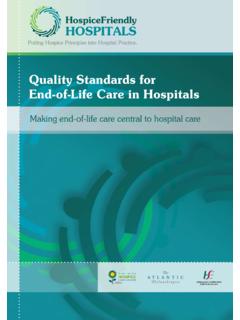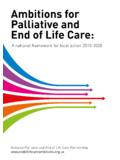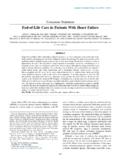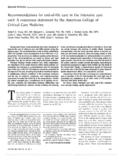Transcription of Palliative Care (Supportive and End of Life Care) A ...
1 Palliative care ( supportive and End of life care ). A Framework for Clinical Practice in Perinatal Medicine Report of the Working Group August 2010. British Association of Perinatal Medicine (BAPM). 5 11 Theobalds Road London, UK. WC1X 8SH. Tel: +44 (0)20 7092 6085. Fax: +44 (0)20 7092 6001. Email: Website: / Registered Charity No: 285357. The British Association of Perinatal Medicine Wishes to thank the following for their contribution in producing this document: Mr Andy Cole Bliss, London Dr Finella Craig Great Ormond St Hospital, London Ms Clare Daly Great Ormond St Hospital, London Dr Sharon English Leeds General Infirmary, Leeds Ms Sally George Antenatal Results & Choices (ARC), London Dr Bryan Gill Leeds General Infirmary, Leeds Ms Lindis Harris Maidstone Hospital, Maidstone Dr Anthony Kaiser St Thomas' Hospital, London Dr Christoph Lees Addenbrooke's Hospital, Cambridge Ms Alexandra Mancini Chelsea & Westminster Healthcare Trust, London Dr Mike Miller Martin House Hospice, Boston Spa Dr Edile Murdoch (Chair).
2 Addenbrooke's Hospital, Cambridge Mrs Judith Schott Sands, London Dr Norman Smith Aberdeen Maternity Hospital, Aberdeen Dr Helen Statham University of Cambridge, Cambridge Palliative care ( supportive and end-of- life care ). A Framework for Clinical Practice in Perinatal Medicine Supplement report of the working group Summary: key components of the framework. Decisions about perinatal end of life care planning should be based on the best possible information on the diagnosis and prognosis of the underlying condition. Palliative care should only be considered if the fetus or baby has a candidate condition. If a woman decides to continue her pregnancy knowing that her baby has a condition that will cause significant disability but is non lethal, the baby is not necessarily eligible for Palliative care . Joint decision making with parents, open communication and clear documentation are essential for good decision making and the delivery of the care plan.
3 An individualised integrated care plan should be drawn up after multidisciplinary discussions between clinical specialists, the parents and the team that will provide Palliative care . Antenatal and postnatal care of the mother need to be included in the care plan. The care plan should cover all foreseeable outcomes. It should be flexible enough to allow for changes in the condition of the mother or the baby and in the parents' views and wishes. Introduction Advances in antenatal diagnosis of fetal abnormalities, obstetric care , neonatal care and care at the margins of viability have all increased need for decision making about end-of- life care for the fetus and neonate. These decisions present clinicians and parents with new and difficult challenges. 1. Background Antenatal diagnoses of lethal abnormalities and of conditions which are associated with a significant risk of death are being confirmed earlier in pregnancy.
4 A plan for Palliative care may be needed at any stage in pregnancy, especially when the diagnosis is made at or beyond 20-22 weeks gestation. Palliative care may also be needed in the early perinatal period, for example because of extreme prematurity, or the diagnosis of a condition with a very poor long-term prognosis. Recent guidance from the Nuffield Council of Biothetics (Nuffield 2006) and the British Association of Perinatal Medicine working group on the clinical care of extremely preterm infants supports the decisions of clinical staff and parents not to resuscitate or institute intensive care when this would not be in the baby's best interests. The Department of Health is developing guidance on end-of- life care for adults but not yet for the fetus, neonate, or infant. -1- The aim of this document is to provide guidance for clinical staff on clinical decision making and on developing integrated care pathways for perinatal Palliative care .
5 It highlights key practice points to help clinical staff to develop consistent high quality care and help develop uniform standards of care wherever families are cared for. It should be used in conjunction with other guidance in particular the ACT Neonatal Pathway 2009. 2. Definition Perinatal Palliative care is defined here as the planning and provision of supportive care during life and end-of- life care for a fetus, newborn infant or infant and their family in the management of an appropriate candidate condition. 3. Candidate conditions for perinatal Palliative care These can be considered in five broad Categories. Category 1. An antenatal or postnatal diagnosis of a condition which is not compatible with long term survival, bilateral renal agenesis or anencephaly. Category 2. An antenatal or postnatal diagnosis of a condition which carries a high risk of significant morbidity or death, severe bilateral hydronephrosis and impaired renal function.
6 Category 3. Babies born at the margins of viability, where intensive care has been deemed inappropriate. Category 4. Postnatal clinical conditions with a high risk of severe impairment of quality of life and when the baby is receiving life support or may at some point require life support, severe hypoxic ischemic encephalopathy. Category 5. Postnatal conditions which result in the baby experiencing unbearable suffering in the course of their illness or treatment, severe necrotizing enterocolitis, where Palliative care is in the baby's best interests. 4. Criteria for establishing a candidate condition Criteria for Categories 1 and 2. Palliative care should only be considered when the diagnosis of an abnormality has been confirmed. Karytopypic abnormalities and single gene defects may be diagnosed by CVS, amniocentesis or cordocentesis in the antenatal period. Structural abnormalities are usually picked up at routine ultrasound screening.
7 Antenatal diagnosis of a structural abnormality should be confirmed by a fetal medicine consultant. In many cases, other investigations such as MRI or 3D or 4D ultrasound should be used to confirm the diagnosis or provide further information. Cardiac anomalies should be assessed by a perinatal cardiologist using fetal specialist echocardiography. These investigations should be followed by a multidisciplinary team (MDT) discussion to agree the diagnosis and prognosis and to consider any implications for maternal health. This is not essential in fetal conditions for which there are simple definitive diagnostic tests and an agreed prognosis, anencephaly, however it is essential in the case of many structural abnormalities. Communication aids such as video conferencing and -2- video telemetry in real time should be considered when the specialist unit and the referring unit are in different localities.
8 The diagnosis and prognosis is then explained and discussed with the family. If either the parents or members of staff are still uncertain about the diagnosis or prognosis, a second opinion, either internal or external, should be sought. This should be arranged by the department, although some parents may want to choose another tertiary centre and this should be facilitated. Deciding on either Palliative care or termination of pregnancy In Categories 1 and 2, both the option of continuing the pregnancy with Palliative care and the option of terminating the pregnancy should be discussed with the parents. These discussions are usually held with the fetal medicine team. Palliative care is not an option if an abnormality which does not fulfill Criteria 1 or 2 is diagnosed during pregnancy. Knowing that the baby will live but with significant impairment, the mother can choose to terminate or to continue her pregnancy.
9 When an abnormality is diagnosed antenatally but it is not clear that it fulfils the criteria for Category 2, the mother should be told that decisions about the baby's care can only be taken after the birth. As active rather than Palliative care could be appropriate, a mother who is certain that she cannot cope with a disabled child may wish to have a termination. It is important to note that not all pregnancies which fulfil the criteria for late termination of pregnancy under section E of the Abortion Act, would be suitable for Palliative care . For example, most fetal medicine specialists would regard severe ventriculomegaly (with a posterior horn diameter of >15mm) as grounds for termination of pregnancy at 24. weeks or beyond. However, this condition would not automatically be grounds for instituting perinatal Palliative care unless the infant's condition also fulfilled the criteria for Categories 4 or 5 above.
10 Criteria for Category 3. The British Association of Perinatal Medicine guidance document The Management of Babies Born Extremely Preterm at Less Than 26 Weeks of Gestation' outlines situations at the margins of viability when withholding or withdrawing active resuscitation is an appropriate option. Criteria for Category 4. It is important that the diagnosis and prognosis of a condition in Category 4 are as accurate as possible. In order to achieve this, it may be helpful to have an appropriate second opinion or investigations such as MRI, other imaging, and genetic testing. If these are not available locally, transfer to an appropriate centre should be considered. The prognosis for the baby should be agreed by at least two paediatricians/neonatologists. These may be internal or external second opinions, depending on the unit's referral pathways. An MDT meeting should be considered if there is uncertainty about the prognosis, or if further opinions from other disciplines ( paediatric neurology) are required.







